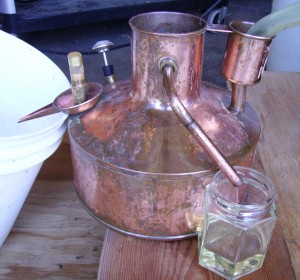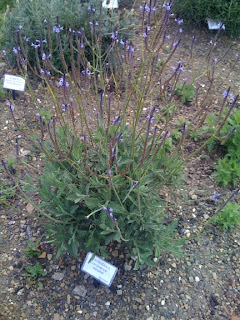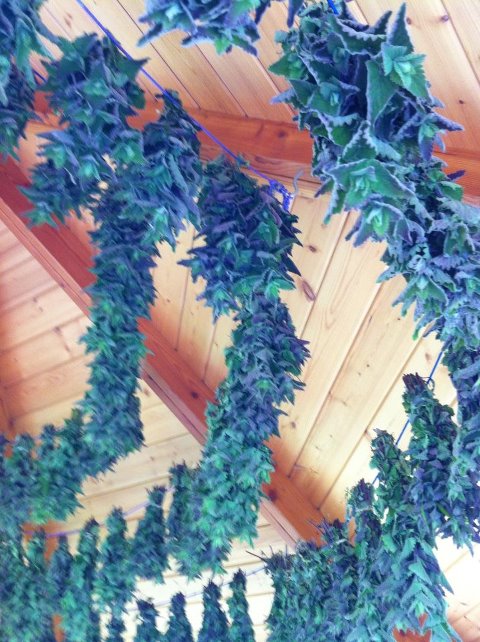
We are growing more than lavender around here. Over the last couple of days we’ve harvested a lot of one of lavender’s cousins, catnip. Both these plants are in the lamiaceae family (mints are in that family, the members of this family have square stems).
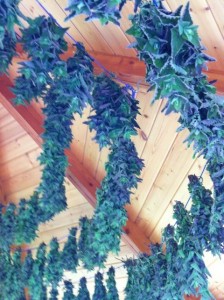
If you’ve ever watched what happens when you put a cat and a pot of catnip (Nepeta cataria) together, you’ve witnessed what could rightly be called the feline version of reefer madness. Most cats, even lions and tigers, are helplessly drawn to nepetalactone, an aromatic compound in the plant’s leaves. They’ll energetically play with catnip-stuffed toys — even roll on the plants themselves! — and become frisky, playful, and even amorous. Most cats find it irresistible, but not all cats. It’s been discovered that sensitivity to catmint is inherited, so if your cat turns her nose up at catnip, it may just be that she’s immune to its spell and not a big party pooper. We have our own quality tester. Lavender Wind Farm’s cat, Siduri,

who’s job is to make sure the current year’s crop is excellent for cats.
For people, on the other hand, Nepetalactone has the opposite effect. Catnip tea is traditionally used to reduce tension, nervousness, and anxiety. And like many other members of the mint family, it can settle a stomach and ease motion sickness. For generations, in fact, herbalists have recommended it to relieve discomfort in colicky babies.
Catnip (Nepeta cataria)
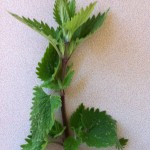
and Catmint (Nepeta x fassennii)
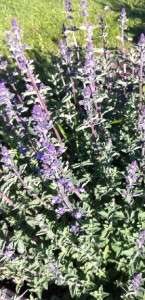
are actually different plants. Cats are not attracted to catmint the way they are to catnip, although sometimes one will be interested. Catmint has graceful long spires of blue flowers. Catnip’s flowers are white. Catnip will reseed itself and can become a bit of a pest, whereas, Catmint will not reseed (being a hybrid, its seeds are sterile). If you want blue beauty in your garden most of the summer, Catmint is your plant.
Catnip is the more potent when it comes to herbal effects. As mentioned above, it has numerous health benefits when used as either a tea (infusion) or tincture. A researcher at Cornell University1 says that Catnip developed it’s unique scent and chemical profile to repel insects that might want to chomp on its leaves. This turned out to be a great hint to researchers who seek mosquito repellants. Catnip essential oil has been shown to be effective against those pesky, buzzing, disease bringers – but the effect varies depending on how, where, and when the oil is distilled.
For an easy way to protect against bugs, you can use catnip, along with lavender, and make some bug repellant sachets. Combine dried catnip and dried lavender and use that mixture to stuff sachet bags. Put them in your closet and drawers for a much more natural and pleasant way to keep moths and bugs at bay.
Catnip is an amazing plant – your stomach, your cat, your skin, and your clothes will thank you for growing and using it.
(Authors: Sarah Richards & Toni Grove)



 Lavender buds (the bits of flowers that are stripped off the stems) that are used in sachets hold their scent for a long time. During the first year after harvest they put out a lot of sweet aroma. After the first year all you have to do is squeeze them and the natural oils will release and the scent will refresh. We’ve had some sachets that were still putting out sweet smells 10 years after they were put in our underwear drawer.
Lavender buds (the bits of flowers that are stripped off the stems) that are used in sachets hold their scent for a long time. During the first year after harvest they put out a lot of sweet aroma. After the first year all you have to do is squeeze them and the natural oils will release and the scent will refresh. We’ve had some sachets that were still putting out sweet smells 10 years after they were put in our underwear drawer.